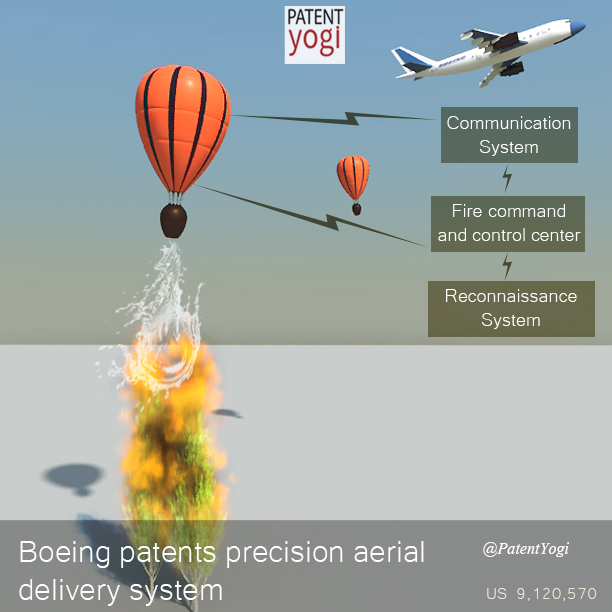Present aerial fire-fighting methods need dedicated aircraft that have little utility for other missions, are limited in fire-fighting capacity due to a small dedicated fleet and severe operational restrictions, need specialized pilot training, are limited to daylight operations, and need to fly at low altitude in very dangerous conditions. The present invention relate to guided air-deployable fire-suppression agent delivery systems.
Patent Number: 9,120,570
Patent Title: Precision aerial delivery system
Inventors: Hoisington; Zachary Charles (Long Beach, CA), Rawdon; Blaine Knight (San Pedro, CA)
Assignee: The Boeing Company (Chicago, IL)
Family ID: 1000001309911
Appl. No.: 13/776,733
Filed: February 26, 2013
Abstract: A system and methods for deployment operations from an airborne vehicle are presented. A designated location of a target is received at a flight control system coupled to a location tracking guided container comprising an agent. The location tracking guided container is ejected at an ejection point from the airborne vehicle approximately above the designated location of the target to descend at a descent rate and a descent angle. A calculated path to the designated location is calculated based on the designated location and a current location of the location tracking guided container. The location tracking guided container is aerodynamically guided by a glide control structure to fly along the calculated path from the ejection point to a load release altitude near the designated location of the target. The agent is delivered to the designated location of the target by releasing the agent at the load release altitude near the designated location.
Claim 1: A method for deployment operations from an airborne vehicle, the method comprising: receiving a designated location of a target by a flight control system coupled to a location tracking guided container comprising a fire-suppression agent; ejecting at an ejection point the location tracking guided container from the airborne vehicle approximately above the designated location of the target to descend at a descent rate and a descent angle; calculating during descent, by a processor in the location tracking guided container, a calculated path to the designated location based on the designated location and a current location of the location tracking guided container; aerodynamically guiding the location tracking guided container by a glide control structure coupled thereto under control of the processor in the location tracking guided container independent of the airborne vehicle to fly along the calculated path from the ejection point to a load release altitude near the designated location of the target, controlling an actuator to operate a first suppression agent flow-control valve to control a flow rate of the fire suppression agent based on an operational condition of the location tracking guided container; and delivering the fire-suppression agent to the designated location of the target by releasing the agent at the load release altitude near the designated location.

